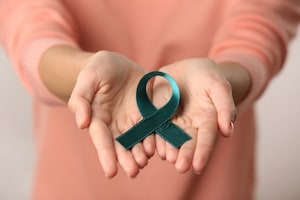Stages of Ovarian Cancer
 Ovarian cancer is a rare type of cancer that begins in the ovaries. Ovarian cancer is difficult to detect in the beginning stages because there are often little to no symptoms. Unfortunately, when the cancer is detected in the later stages, it is more difficult to treat. Approximately 21,000 women in the United States are diagnosed with ovarian cancer each year, and over half of those women die from it. Risk factors for ovarian cancer include obesity, age and genetics. However, if the cancer is caught early-on, there are many treatment options available that yield success. Furthermore, diagnoses are declining and they have slowly decreased over the past 20 years. Because ovarian cancer warning signs are difficult to detect early-on, it is important to understand and recognize the common symptoms.
Ovarian cancer is a rare type of cancer that begins in the ovaries. Ovarian cancer is difficult to detect in the beginning stages because there are often little to no symptoms. Unfortunately, when the cancer is detected in the later stages, it is more difficult to treat. Approximately 21,000 women in the United States are diagnosed with ovarian cancer each year, and over half of those women die from it. Risk factors for ovarian cancer include obesity, age and genetics. However, if the cancer is caught early-on, there are many treatment options available that yield success. Furthermore, diagnoses are declining and they have slowly decreased over the past 20 years. Because ovarian cancer warning signs are difficult to detect early-on, it is important to understand and recognize the common symptoms.
Common symptoms include:
- Bloating;
- Cramping;
- Feeling full quickly;
- Frequent urination;
- General fatigue; and
- Changes in your menstrual cycle.
If ovarian cancer runs in your family, or you suspect you may have it, speak to your doctor. Your doctor may have to do a series of personalized tests including imaging, a biopsy and blood tests to determine your diagnosis. The Roswell Park Comprehensive Cancer Center, an institution in Buffalo, New York, helps treat patients with ovarian cancer every day and are trained to diagnose and treat those with cancer in Buffalo, New York; Niagara Falls, New York; Rochester, New York; and throughout New York State.
The Four Stages Of Ovarian CancerStage 1:
At Stage 1, the cancer is only in the patient’s ovaries and has not yet spread to the abdomen, pelvis or lymph nodes. There are three substages within Stage 1:
- Stage 1A: the cancer is inside one ovary;
- Stage 1B: the cancer is inside both ovaries; and
- Stage 1C: the cancer is inside one or both ovaries, and one of the following: the outer capsule bursts, causing cancer cells to leak into the stomach or pelvic area; cancer is found on the outside surface of the ovary; or, cancer is found in the fluid from the abdomen.
Stage 2:
At Stage 2, the cancer is in the patient’s ovaries and has spread to somewhere in the pelvic region. The more specific substages include:
- Stage 2A: the cancer has moved to the fallopian tubes or uterus; and
- Stage 2B: the cancer has moved to other nearby organs.
Stage 3:
At Stage 3, the cancer is in the patient’s ovaries and the cancer has spread outside of the pelvic region. The three substages include:
- Stage 3A: the cancer was found in other pelvic organs and the lymph nodes in the abdomen;
- Stage 3B: the cancer has spread to nearby organs in the pelvis; and
- Stage 3C: the cancer has spread in large amounts outside the spleen or liver, or has spread to the lymph nodes.
Stage 4:
Stage 4 is the most advanced stage. The cancer has spread throughout the body to distant sites include the spleen, lungs and liver. The two substages of Stage 4 include:
- Stage 4A: the cancer cells are in the fluid around the lungs; and
- Stage 4B: the cancer has moved inside the spleen or liver, distant lymph nodes or other distant organs including the skin, lungs or brain.
In addition to the four stages of ovarian cancer, there are three types of ovarian cancer. The three types are defined by the origin of the cancer cells:
- Epithelial cells: cells that are on the ovary’s outer lining;
- Stromal cells: cells that are inside of the ovary’s tissues; and
- Germ cells: cells that will eventually produce eggs.
 Depending on the stage and the type of ovarian cancer, the treatment plan will be personalized to meet exact needs of the patient. In general, ovarian cancer is only detected after it has metastasized or spread to other parts of the body. Doctors will likely use a combination of the following treatments in order to create a plan that will work the best for each specific diagnosis.
Depending on the stage and the type of ovarian cancer, the treatment plan will be personalized to meet exact needs of the patient. In general, ovarian cancer is only detected after it has metastasized or spread to other parts of the body. Doctors will likely use a combination of the following treatments in order to create a plan that will work the best for each specific diagnosis.
- Surgery. Surgical removal of the cancer may require the removal of one or both ovaries, or a combination of both of the ovaries and the uterus, fallopian tubes and nearby lymph nodes.
- Chemotherapy. Chemotherapy is the use of strong chemicals to kill, slow or stop the growth of cancer cells in the body. However, chemotherapy can kill healthy cells and cause serious side effects. Therefore, chemotherapy is given in cycles to give the body time to recover in between treatments. Chemotherapy drugs can be inserted through an IV or taken orally. Chemotherapy is often used in conjunction with surgery to help kill off any remaining cells.
- Hormone Therapy. Hormone therapy is the use of hormones or hormone-blocking medicines to alter the progesterone and estrogen levels, which can affect the growth of the ovarian cancer cells.
- Radiation Therapy. Radiation therapy uses X-rays to kill cancer cells and shrink tumors. This is rarely used for ovarian cancer, but can be used in areas where the cancer has spread.
- Targeted Therapy. Targeted therapy is a newer treatment that targets the cancer cells and does little to no damage to the surrounding healthy cells.
There are various treatment methods available for fighting ovarian cancer that are effective. Luckily, there are many expert oncologists and physicians in Buffalo, New York that will help cancer patients get the treatment they need.
Lastly, there are currently many lawsuits that claim the use of talcum powder products and Johnson & Johnson’s baby powder products cause ovarian cancer. If you believe that your ovarian cancer has been caused by the use of these products, contact the Dietrich Law Firm P.C. as soon as possible so that we can investigate your claim. For more information, visit our webpages: Johnson & Johnson and Talcum Powder Ovarian Cancer. Jed Dietrich, Esq. and his talcum powder ovarian cancer attorneys are here to help you. Call now at 716-839-3939.
Call the Dietrich Law Firm P.C. immediately at 716-839-3939 so that our aggressive, tenacious and hardworking personal injury lawyers can fight to obtain the best result for your personal injury claim in Buffalo, New York. We are available 24 hours a day, 7 days a week, and there is never a fee until we WIN for you!
 Dietrich Law Firm P.C. Home
Dietrich Law Firm P.C. Home














